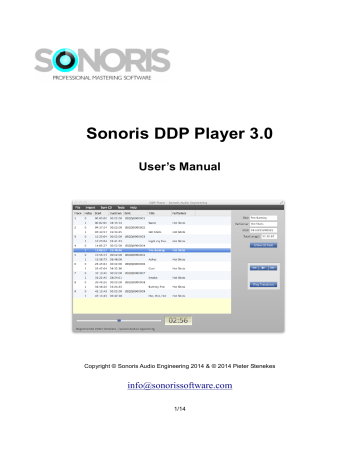

First, it reduces a step in the manufacturing process. DDP has some advantages over a master CD. However, not everyone gave up on DDP and with good reason. For a while, it seemed like a burned CD was the only format most plants received. As the data tape formats began to fade (and CD burners became more affordable), fewer masters were submitted via DDP. When it was a popular album delivery format, DDP masters were written to 8 mm Exabyte tape, 4 mm DAT, or Digital Linear Tape (DLT), and shipped to the plant. DDP was extended to DVD in 1996, with High Density formats added in 2006, and continues to be licensed and kept current by DCA. DDP stands for Disc Description Protocol, a format originated by Doug Carson Associates (DCA). With audio CDs being the predominant delivery format, there are mastering engineers who haven't heard of DDP. Of course, if you're still wondering what a DDP is, you're not alone. A second security feature limits DDP imports so a customer can only open a DDP coming from your studio, preventing the load-in of competitors' DDP files. Its most significant feature is encryption of the file-set that precludes anyone but the intended receiver from opening the DDP. Since many clients are concerned about the security of their intellectual property, a Security Option is available as an additional-cost option.
#WHAT IS DDP AUDIO LICENSE#
OEM customers receive a license from Sonoris allowing engineers to send any number of copies freely to customers. For example, when I send DDP Player OEM to my clients, the branding elements, including the application icon, are plastered with Treelady Studios' logo and contact information. The OEM version has all the features of the regular Sonoris DDP Player application but comes with a customized splash screen and help section with your studio branding, logo, name, address, and website URL. And there's always the send-one-big-glob-of-audio option, but that doesn't show where start and end flags will be, etc. Some engineers send disc images or Roxio Toast images, but these options require that the client owns a copy of Toast or Jam and has the computer skills to import the image, load it, and make a copy. Of course, people have cobbled together workarounds. Reviewing factors such as crossfades, relative loudness, and spacing has been difficult at best. Of course, audio engineers have been able to send audio over the internet for quite some time, but sending individual songs is not the same as a complete master. A PQ reference sheet can be viewed or printed, allowing the client to confirm spellings for CD TEXT and ISRC allocations. (This topic is beyond the scope of this article, but an MD5 checksum is a cryptographic hash function used to check the integrity of files.) Inside the program, the audio can be auditioned via the onscreen playback controls or can be burned as a reference copy by the client's machine. To be sure the DDP is a bit-for-bit clone of the master, the Tools menu lets you check the MD5 checksum file for validation. The client imports the files into DDP Player OEM for review. (Version 1 is also supported.) The DDP files are transferred to the client electronically or on physical media such as CD-R, USB drive, or hard drive. The mastering engineer exports the client's finished project in DDP 2.0 format.
#WHAT IS DDP AUDIO PC#
The client installs the application on a PC or Mac. The mastering house provides the client with a copy of DDP Player OEM and a license code. This saves money and hastens the approval process. There is no need for the band to travel to the mastering house.

If you're wondering why this matters, it means that artists can review masters remotely. The file format specification is not freely available.Īn optional text file, containing the track titles and timings, can also be included.This standalone, cross-platform application allows mastering engineers to provide complete evaluation masters to artists. DDP is a proprietary format and is the property of DCA. Please help improve this article by introducing citations to additional sources.įind sources: "Disc Description Protocol" – news ĭisc Description Protocol (DDP) is a format for specifying the content of optical discs, including CDs and DVDs.ĭDP is commonly used for delivery of disc premasters for duplication. Relevant discussion may be found on the talk page. This article relies largely or entirely on a single source.


 0 kommentar(er)
0 kommentar(er)
